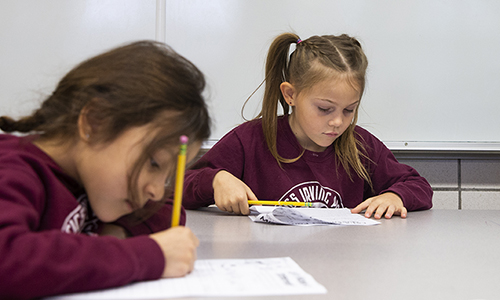Working paper
Impacts of school entry age on academic growth through 2nd Grade: A multi-state regression discontinuity analysis
2020
By: Angela Johnson, Megan Kuhfeld

Description
The belief that additional time allows children to become more ready for school has affected public policy and individual practices. Prior studies estimated either associations between school entry age and academic growth or causal effects on achievement measured at one or two points. This paper contributes novel causal evidence for the impacts of kindergarten entry age on academic growth in the first three years of school. We embed regression discontinuity into a piecewise multilevel growth model and apply it to rich assessment data from three states. Being a year older leads to higher initial achievement and higher kindergarten growth rates but lower growth rates during 1st and 2nd grades. Effects do not differ by gender or race.
See MoreTopics: Growth modeling, Early learning
Associated Research
Related Topics


The current investigative study uses a multiple-indicator, latent-growth modelling (MLGM) approach to examine the longitudinal achievement construct and its invariance for MAP Growth.
By: Shudong Wang, Hong Jiao, Liru Zhang
Topics: Measurement & scaling, Growth modeling


Modeling student growth has been a federal policy requirement under No Child Left Behind (NCLB). In addition to tracking student growth, the latest Race To The Top (RTTP) federal education policy stipulates the evaluation of teacher effectiveness from the perspective of added value that teachers contribute to student learning and growth. Student growth modeling and teacher value-added modeling are complex.
Topics: Growth modeling, Measurement & scaling, Student growth & accountability policies


Modeling student test-taking motivation in the context of an adaptive achievement test
This study examined the utility of response time-based analyses in understanding the behavior of unmotivated test takers. For an adaptive achievement test, patterns of observed rapid-guessing behavior and item response accuracy were compared to the behavior expected under several types of models that have been proposed to represent unmotivated test taking behavior.
Topics: Measurement & scaling, Growth modeling, School & test engagement


The development of racial/ethnic and socioeconomic achievement gaps during the school years
This study examined developmental trends in academic achievement gaps between poverty and race/ethnicity groups from school entry to middle school using two large longitudinal data sets. We used time-varying effect modeling (TVEM) to estimate how the associations among race/ethnicity, poverty status, and math and reading achievement vary across continuous age from age 5 to age 15.
By: Megan Kuhfeld, Elizabeth Gershoff, Katherine Paschall
Topics: Equity, Growth modeling


How the Primary Grades Can Save Us: Growing American Reading Comprehension
When recent NAEP results came out, the bleak headline was that American students are not getting better at reading comprehension. When the NAEP folks convened a panel of reading experts in early April, the primary grades got called out as one potential culprit. So what needs re-evaluating in K-3 literacy? One reasonable place to look is at oral reading fluency and the foundational skills that feed word decoding.
Topics: Early learning, Academic content, Reading & language arts


This kindergarten sneak preview helps families hit the ground running
For three weeks in the summer, children who are entering kindergarten in Portland, Oregon, get ready and get excited to start school. While it’s no substitute for pre-K, getting a preview helps ease the transition for kids, and offers parents a sense of connection. Special correspondent Lisa Stark of Education Week reports.
PBS News Hour
Mentions: Beth Tarasawa
Topics: Early learning, Equity, High-growth schools & practices


In this study, we apply the Compound Polynomial or “CP” model in a school evaluation context. The CP model addresses the seasonality of student test scores by simultaneously estimating between- and within-year growth.
Topics: Growth modeling, Seasonal learning patterns & summer loss, Student growth & accountability policies



